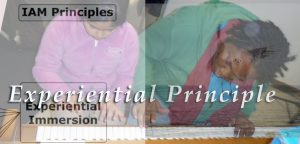This page explains in general terms the first IAM principle – experiential.
Overview of Experiential Principle
The experiential principle reinforces the idea of encoding new knowledge through physical and direct experience, allowing interpretive reflection on the part of participants themselves. The experiences in which we engage are encoded into our nervous systems through the development of fibre connections in the brain (Goswami 2008, 387). This physiological encoding is enhanced when its presentation is not only cognitive, but also includes physical-based experience involving the motor system and other faculties. The integration of multiple senses during initial encoding of knowledge creates broader fibre connections for better recall (Goswami 2008, 389). For most students, absence of threat and a safe environment are essential in this encoding process. Also, the association of students’ previous knowledge with new knowledge enhances the encoding (Caine and Caine 1990). All these points are explained in detail in chapter 2 of Integrated Arts Pedagogy and Philosophy (Soyfer 2016, 43-134).
 The experiential principle is facilitated by first ensuring that students want to achieve something specific, and then motivating and guiding their experience in the context of this learning goal achievement, towards mastery of a given subject area. This process involves three stages, 1) activating students’ intrinsic motivation for a specific achievement (incorporating students’ wishes), 2) guiding students’ immediate immersion into manageable experience towards this achievement (by finding manageable elements or modifying materials at first), and 3) subsequent perfecting of this experience itself to achieve a specific learning objective. For example, learning to play a piece of music that is beyond a given student’s current level can be accelerated by immersing the student in manageable aspects of this piece. By sustaining the student’s belief in the manageability of the piece, the teacher takes advantage of the student’s intrinsic motivation to accelerate the student’s learning to a new level of achievement. This occurred several times in group and private settings of my pedagogical practice (e.g., a grade 3 piano student learning Chopin’s Fantaisie Impromptu in about a month, and a group of beginners performing a prepared ensemble repertoire, improvising on stage, and composing after about 15 weeks), and this process is reproducible. Note that making the student first learn a less desired simpler piece fails to leverage the student’s intrinsic motivation, and is thus very different from what I propose.
The experiential principle is facilitated by first ensuring that students want to achieve something specific, and then motivating and guiding their experience in the context of this learning goal achievement, towards mastery of a given subject area. This process involves three stages, 1) activating students’ intrinsic motivation for a specific achievement (incorporating students’ wishes), 2) guiding students’ immediate immersion into manageable experience towards this achievement (by finding manageable elements or modifying materials at first), and 3) subsequent perfecting of this experience itself to achieve a specific learning objective. For example, learning to play a piece of music that is beyond a given student’s current level can be accelerated by immersing the student in manageable aspects of this piece. By sustaining the student’s belief in the manageability of the piece, the teacher takes advantage of the student’s intrinsic motivation to accelerate the student’s learning to a new level of achievement. This occurred several times in group and private settings of my pedagogical practice (e.g., a grade 3 piano student learning Chopin’s Fantaisie Impromptu in about a month, and a group of beginners performing a prepared ensemble repertoire, improvising on stage, and composing after about 15 weeks), and this process is reproducible. Note that making the student first learn a less desired simpler piece fails to leverage the student’s intrinsic motivation, and is thus very different from what I propose.
The first step toward leveraging intrinsic motivation is uncovering a desire which can ensure the student’s maximal effort. The educator can then guide this effort by customizing the presentation of material to a given student and by parallel incorporation of other related knowledge required for its mastery. This concept need not be limited to the performing arts.
To summarize, facilitation of the experiential principle involves three key aspects: 1) a selection of materials, i.e., giving students choices to increase eagerness for the experience; 2) initial simplification of materials, i.e., simplifying difficult materials at first to allow immediate participation; and 3) manageably increasing the complexity levels of materials, i.e., stimulating students by maintaining challenge while they improve toward their intended objectives.
All three aspects involve adaptation of materials to make them appealing and manageable for a given student. The key here is that the educator selects and adjusts the learning curve appropriately for each individual student. Learning curve steepness is reduced by simplification, or increased by challenge as needed to ensure the chosen activity is achievable, instructive, and interesting for each student.
The facilitation of these three aspects is exemplified in Dr. Soyfer’s dissertation through IAM’s pedagogical approach to teaching the sample music repertoire, i.e., in chapter 3 and appendix B (Soyfer 2016, 136-248, 354-563); and all three subject areas: music, dance, and visual arts, i.e., in chapter 4 and appendix A (Soyfer 2016, 250-298, 314-353).
Read an overview of all three IAM Principles here.
Bibliography:
Caine, Renate Nummela and Geoffrey Caine. 1990. “Understanding a Brain-Based Approach to Learning and Teaching.” In Educational Leadership, vol. 48, no. 2: pp. 66-70. http://www.ascd.org/ASCD/pdf/journals/ed_lead/el_199010_caine.pdf (accessed October 6, 2014).
Goswami, Usha. 2008. “Principles of Learning, Implications for Teaching: A Cognitive Neuroscience Perspective.” In Journal of Philosophy of Education, vol. 42, nos. 3-4, pp. 381–399. http://onlinelibrary.wiley.com/doi/10.1111/j.1467-9752.2008.00639.x/pdf (accessed February 1, 2015).
Soyfer, Nina. 2016. “Integrated Arts Pedagogy and Philosophy.” Canada: York University.
Please note this page is a direct quote form Dr. Nina Soyfer’s dissertation “Integrated Arts Pedagogy and Philosophy” defended and archived in 2016. All rights are reserved and this post is to be used for educational purposes.
Soyfer, Nina. 2016. “Integrated Arts Pedagogy and Philosophy.” Canada: York University, pp. 1-2, 8-10.